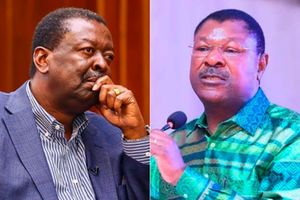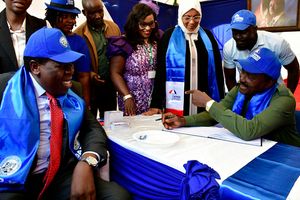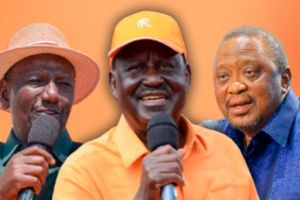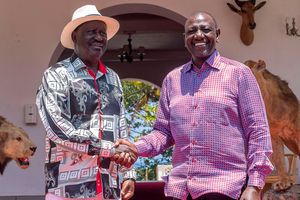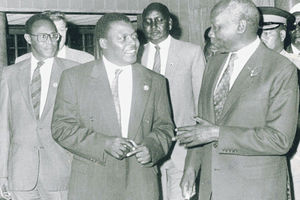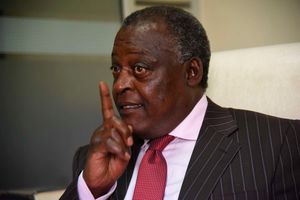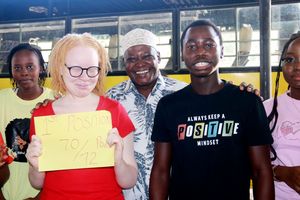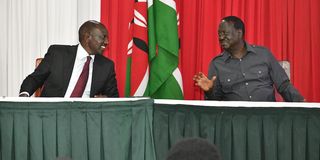
President Willam Ruto and ODM party leader Raila Odinga during the MoU signing event at KICC on March 7, 2025.
President William Ruto and former Prime Minister Raila Odinga, the leading protagonists in the 2022 General Election with a combined 14.1 million votes, Friday inched closer to a 2027 poll deal with a 10-point Memorandum of Understanding (MoU) Nation.Africa understands will immediately be followed with the sharing of positions in government.
Dr Ruto and Mr Odinga, smarting from an unsuccessful attempt by the Kenyan candidate to African Union Commission chairmanship in Ethiopia in February, had been in an informal political cooperation since mid-2024 following youth-led protests in June against taxation and poor governance.
This prompted the president to dissolve his Cabinet, drop the unpopular Finance Bill and turn to the former Prime Minister for political survival.
With it, President Ruto incorporated key allies of Mr Odinga into his reconstituted Cabinet: two ODM deputy party leaders, Hassan Joho (Mining) and Wycliffe Oparanya (Cooperatives); party Chairman John Mbadi (National Treasury), National Assembly Minority Leader Opiyo Wandayi (Energy) and party elections board member Beatrice Askul (East African Community). They subsequently left their party positions to join the so-called broad-based government.
Dr Ruto also appointed other individuals from Mr Odinga’s camp as presidential advisers and in key parastatals.
It was this unified move that allowed President Ruto to impeach his deputy Rigathi Gachagua in October 2024 with the help of ODM legislators in the National Assembly and the Senate. He was replaced by Prof Kithure Kindiki.
Mr Gachagua has since teamed up with Wiper leader Kalonzo Musyoka, People’s Liberation Party boss Martha Karua, Democratic Action Party of Kenya (DAP-K) boss Eugene Wamalwa, and Safina Party boss Jimi Wanjigi with the intention of forming an alliance.
Former Interior Cabinet Secretary Fred Matiang’i is also in the shadows as a potential presidential aspirant so far with the backing of ex-president Uhuru Kenyatta’s Jubilee Party.
And so, the event at the Kenyatta International Convention Centre (KICC) on a sunny Friday afternoon was the culmination of an unlikely political compromise that has been praised and vilified in equal measure: Two sworn enemies in the 2022 elections who are also long-time on-and-off friends and pioneer officials of the 20-year-old ODM.
And the two leaders — President Ruto calling Mr Odinga ‘My brother, Prime Minister’, and the ODM boss replying with ‘My brother, Mr President’, were full of bromance and newfound friendship.
“Very few people can put the interest of the people ahead of their personal interest. My brother Raila (Mr Odinga), history is going to treat you fairly. A few months ago, I called Raila and told him: ‘You have been my party leader, and today, by God’s grace, I am president; I want you to be treated well’,” President Ruto said of Mr Odinga.
“And I will do whatever it takes to make sure that you have respect in Kenya…The contribution you have made to Kenya deserves respect and support,” he added.
Mr Odinga said President Ruto had gone out of his way to campaign for him for the African Union job, which he lost to Djibouti’s Mahmoud Ali Youssouf.
While he insisted that the pact signed on Friday was not a political coalition, he had a rider that the successful implementation of the deal would see it extended to that 2027 elections — and beyond.
“We make it clear that the memorandum we have signed today does not define the formation of a political coalition between ODM and UDA,” Mr Odinga said.
But this came with a disclaimer.
“However, its successful implementation could inform the basis of steps towards the establishment of a broadly constituted and progressive formation for a stable country in future,” Mr Odinga said, giving the biggest indication yet of what’s to come.
The 10 points in the deal include full implementation of the National Dialogue Committee (Nadco) report, which proposes, among others the formation of the post of Prime Minister and that of the Office of the Leader of the Official Opposition.
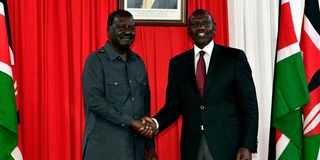
President William Ruto (right) shakes hands with ODM party leader Raila Odinga during the signing of a Memorandum of Understanding between ODM and UDA at Kenyatta International Convention Center in Nairobi on March 07, 2025.
It also calls for inclusivity in all spheres of life, including budgetary allocations and public appointments; protection and strengthening devolution; economic investments and the mainstreaming of the youth and leadership and integrity.
Other pillars of the deal include right to peaceful assembly and compensation of all pending claims of victims of rights infringements; an audit of national debts aimed at finding out how the funds were used; and an intensified fight against corruption. The pact also includes protection and strengthening of accountability institutions like the office of the Auditor General, the Controller of Budget and the Ethics and Anti-Corruption Commission
In addition, the deal also commits to stopping wastage of public resources and protecting the sovereignty of the people, respecting constitutionalism and the rule of law, stopping abductions and respect of press freedoms.
Most of the proposals, a deduction shows, can be addressed through the Constitution and already existing laws, but the political and joint goodwill was the unsaid highlight.
Nation.Africa has learnt that one of the reasons the deal, which marks the first step of President Ruto working with Mr Odinga, was signed in order wade off the interest Mr Odinga was attracting from his former opposition allies in Azimio who wanted him to join them in the fight against the Ruto administration.
“There were interests, even the former President Uhuru Kenyatta called him for a meeting in the Coast, so we had to sign the deal to ensure such people are not given any opportunity to look for him (Raila) again,” said a source with knowledge of the negotiations, but who spoke in confidence.
The Ruto camp also reportedly wanted the MoU signed as the first step ahead of reorganisation of his Cabinet where more allies of Mr Odinga are expected to get top positions.
According to the source, the list of both CSs and Principal Secretaries was finalised when President Ruto met with Mr Odinga in Mombasa last week.
The source said the finer details of the deal on other benefits Mr Odinga will get from the government will be concluded soon.
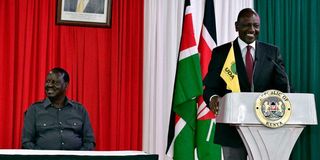
President William Ruto (right) delivers his speech during the signing of a Memorandum of Understanding between ODM and UDA at Kenyatta International Convention Center, Nairobi on March 07, 2025.
This week, Mr Odinga’s allies in Parliament have benefited from the broad-based arrangement of the two leaders with ODM Senators such as Oburu Oginga (Energy), Eddie Oketch (Roads, Transport and Housing) Mohamed Faki (Lands, environment) and natural resources) bagging the chairpersons’ positions in the Senate.
The same trend is expected to be replicated in the National Assembly, which is scheduled to conduct its committee elections next week.
There was also the aspect of Mr Odinga calming his supporters whom he had promised to give a way forward this week.
When moving around the country to “consult” his supporters, Mr Odinga promised that his decision will be to the interest of all Kenyans.
Speaking during the signing ceremony at KICC, President Ruto said the agreement is not about the two of them sharing political positions or winning elections but about the people of Kenya.
“We need to make decisions that are correct as far as the people of Kenya are concerned, not statements that are correct politically,” President Ruto said.
Mr Odinga revealed that when he came back after losing out on the African Union Commission chairperson bid, he was handed a document to sign at State House, Mombasa. The former Prime Minister said he told the President that he needed to consult his people first before signing.
“I found the document had already been prepared but I said I won’t sign until I consult my people. That is when I went to Kisumu, Homa Bay, Mombasa, Wajir, Kisii, Narok and Nairobi to talk to the people,” Mr Odinga said.
Mr Odinga said through the MoU, they will embark on steps to realign the country's economic, social and political priorities to address the youth agenda that has progressively fallen behind in the last 62 years of our independence.
In protecting devolution, Mr Odinga said counties should get not less than Sh450 billion in the 2025/26 financial year.
The former Prime Minister said they will prioritise youth unemployment in the MoU as politicians have taken advantage of their hopelessness to use them for their own selfish political gains.
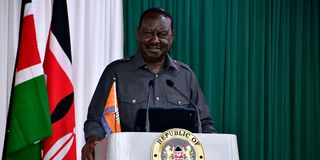
ODM party leader Raila Odinga makes his remarks after the signing of a Memorandum of Understanding (MoU) between ODM and UDA at the Kenyatta International Convention Center in Nairobi on March 07, 2025.
Deputy President Kithure Kindiki said the coming together of the two leaders with massive political support across the country will accelerate the resolving of issues that have affected the country for many years.
“It is not in doubt that the two of you have the largest political infrastructure in the country. If you were individualistic, you could have chosen to flex political muscles hence could have impeded development in the country,” Prof Kindiki said.
Prof Kindiki sent a warning to those playing tribal politics that their game has come to an end with the signing of the MoU between President Ruto and Mr Odinga.
“Those that have invested in parochial, tribal and ethnic divisions, their time has come to an end,” Prof Kindiki.
ODM chairperson and Homa Bay Governor Gladys Wanga said the unity between President Ruto and Mr Odinga is not just about them but about the young people and the minority and those who feel marginalised and thinking they are not part of the country.
On her part, UDA chairperson and Embu governor Cecily Mbarire said the signing of the MoU was a reminder that there comes a time when the interest of the nation is greater than that of individuals.
“I am happy today that we are not signing an agreement to share positions but on issues affecting the people of Kenya,” Ms Mbarire said, adding that it would check-mate those who have been pushing a divisive ethnic agenda.
The signing of the MoU now puts more focus on the implementation of the Nadco report with parliament expected to play a crucial role.
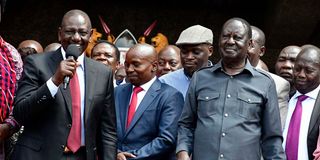
President William Ruto (left) makes his remarks after the signing of a Memorandum of Understanding (MoU) between ODM and UDA at the Kenyatta International Convention Center in Nairobi on March 07, 2025.
The Nadco report was a product of bipartisan consensus between President Ruto and Mr Odinga following a sustained anti-government protests made a myriad of proposals touching on legal and policy reforms and issues of concern to the people of Kenya.
Among the Bills borne out of the report include the Constitution of Kenya (Amendment), Bill, 2023, which if approved by Parliament will change the structure of government seeks to introduce the office of the leader of official opposition and anchor in law the office of the prime minister, the Senate Oversight Fund, the National Government Affirmative Action Fund and the National Government-Constituency Development Fund (NG-CDF).
However, the report had suffered a major blow after the National Assembly committee on Justice and Legal committee in its report rejected a number of proposals contained in it.
The committee rejected the bid to create the office of the leader of the Opposition and two deputies by amending Article 137 (3), the committee maintaining that there was no provision on whether the position would be a public or state office, and in which arm of the government it would be domiciled.
The committee said in its report that creating an official leader of the opposition office saying such a proposal requires a referendum and cannot be done through parliament.

